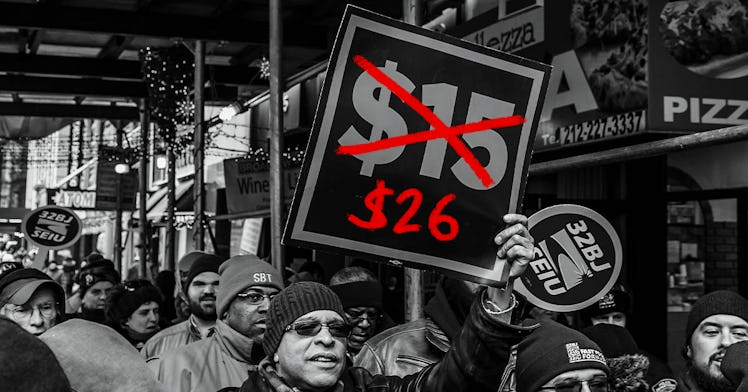Here’s Why Experts Say the Minimum Wage Needs to Be $26/Hour
A family with two earners making $15/hour still can't afford to live in any U.S. state.

The minimum wage in America has remained at $7.25 an hour since 2009. For the past few years, fights to dramatically raise the minimum wage, like the Fight for $15, have taken hold across the United States, and there’s good reason to support it — many millions of American workers earning the minimum wage cannot afford to support their families and struggle to make ends meet. But now, according to economic experts, even $15/hour wouldn’t be enough to support families and doesn’t even accurately reflect how much the economic situation has changed across the country.
In fact, according to experts, the minimum wage needs to be tripled in order to keep up with the economy’s productivity over the last 50 years.
According to the Center for Economic and Policy Research, the minimum wage should be approximately $26/hour, which would allow people working full time to earn more than $50,000 per year. Some would argue that is unreasonable, but CEPR senior economist Dean Baker says that it’s a fair number in 2021.
For families, the current minimum wage is especially brutal, but even a $15/hour wage might not be enough help. It is virtually impossible to try and raise children while only making $7.25 an hour, even if both parents are working full-time. Even as democrats push to raise the minimum wage to $15/hour, experts from CNBC say that would still not be sufficient living wage for families with two earners in any U.S. state.
That’s why many believe the minimum wage needs to be closer to $25-26 per hour.
“That may sound pretty crazy, but that’s roughly what the minimum wage would be today if it had kept pace with productivity growth since its value peaked in 1968,” wrote Baker.
The numbers show that up until the ’70s, the minimum wage was pretty steady with the rate of productivity and cost of living. But since then, the minimum wage has barely increased, which has made it nearly impossible for millions of Americans to have any sort of economic stability.
Just to be clear how large of a scale problem this is, as of 2017, 80.5 million workers 16 and up (or some 58.3 percent of workers) worked hourly wage jobs. Over half a million people earned exactly the federal minimum wage. (A few million people earn less than the federal minimum wage.) 28 percent of all workers, 0r 39 million people, earn less than 15 an hour. And while the median American worker earned about $20 an hour by 2019, these wages are barely enough to help families survive.
Over the last few decades, the consensus has shown that a strong minimum wage will help families survive and thrive. One study found that even raising the minimum wage to $15/hour significantly reduced infant mortality rates. A growing number of workers in the United States have found that they lack the savings to be able to retire at the standard age of 65. Fewer people are having children than ever. A huge part of the depressed birth rate is debt, but there’s no question that low wages play a crucial role in people being unable to save for their future, and unable to choose to have children.
The minimum wage is higher in certain states, including $15/hour in New York and $14/hour in California, but even these more progressive states remain woefully behind where many experts believe the minimum wage needs to be for working parents and workers in general. And 20 states still maintain the federal minimum wage, which means that someone working full time for 52 weeks a year is barely making more than $15,000 per year.
Fortunately, there has been some positive momentum towards increasing the national minimum wage but until that becomes a reality, too many Americans will continue to struggle just to survive financially.